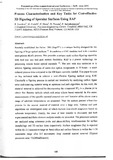JavaScript is disabled for your browser. Some features of this site may not work without it.
| dc.contributor.author | Jourdain, Renaud | - |
| dc.contributor.author | Castelli, Marco | - |
| dc.contributor.author | Shore, Paul | - |
| dc.contributor.editor | Henny, Spaan | - |
| dc.date.accessioned | 2014-05-22T04:01:15Z | |
| dc.date.available | 2014-05-22T04:01:15Z | |
| dc.date.issued | 2010-06-01T00:00:00Z | - |
| dc.identifier.citation | R. Jourdain, M. Castelli, P. Shore. Process characterisation and key tasks for cost-effective 3D figuring of specular surfaces using RAP. Proceedings of the 10th International Conference of the European Society for Precision Engineering and Nanotechnology. 31 May - 4 June 2010, Delft, The Netherlands. | |
| dc.identifier.isbn | 9780955308284 | - |
| dc.identifier.uri | http://dspace.lib.cranfield.ac.uk/handle/1826/8462 | |
| dc.description.abstract | Recently established the Helios 1200 (RaptTM ) is a unique facility designed for the figuring of large optical surfaces [1]. It combines a CNC machine tool with a reactive atom plasma (RAP) process. This provides a unique rapid surface figuring capability with tool size and tool path motion flexibility. RAP is a proven technology for processing silicon based optical materials [2]. The aim with this technique is to achieve figuring correction of metre size optical components in 10 hours - a much reduced process time compared to the 100 hours currently needed. This paper focuses on key technical tasks to achieve a cost-effective figuring method using RAP. Classically a figuring process is carried out iteratively by analyzing surface figure error and removing material using an optimum tool path algorithm. In this work, the material removal is achieved by decomposing the compound SF6 in a plasma jet to obtain free fluorine radicals which etch away silicon based material. In this paper, measurements of the specific material removal rate and footprint of the plume over a range of substrate temperatures are presented. Then the authors present a base-line process for the neutral removal of material over a large area. Various tool path algorithms are investigated some of which include time-dwell adaptation based on substrate temperature. Finally, the issue of heat transfer is discussed, and both experimental and finite element analysis results are presented. The processed surfaces are analyzed using coherence probe and phase-shifting interferometers for surface morphology and 3D surface form respectively. Surface roughness (Sq) is reported within the 2-3 nanometre range on fused silica and surface flatness is within the +/-50 nanometre range after 0.5 micrometre deep material neutral removal (Typical processed area: 70x200millimetre). | en_UK |
| dc.language.iso | en_UK | - |
| dc.title | Process characterisation and key tasks for cost-effective 3D figuring of specular surfaces using RAP | en_UK |
| dc.type | Conference paper | - |
Files in this item
This item appears in the following Collection(s)
-
Staff publications (SAS) [907]
